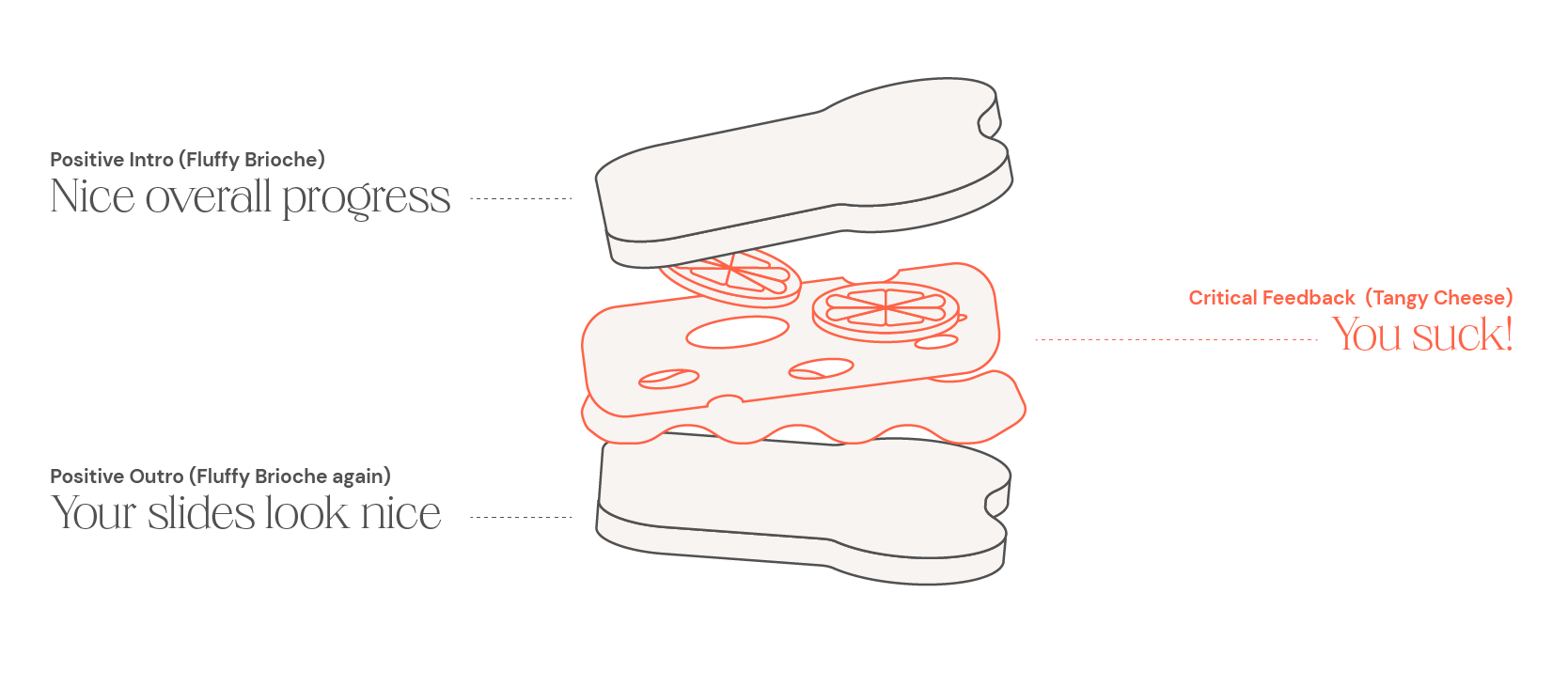Killing the Fast Food Feedback
(Part I)

This post will probably be one of my favorite ones. First, because it will be about feedback, which is by far my most favorite topic within leadership and is the biggest game changer for a better practice IMHO. Second, I get to challenge a method that I’ve seen simply everywhere. So, challenging this method kind of feels like taking up the final boss ;) I'm talking about the feedback sandwich.The holy grail of communicating feedback. It has been part of almost every leadership training I participated in. I’m pretty sure that even though you might not have used the tool yourself, you’ve been sandwiched at least once. For some reason, maybe it’s very simplistic structure, it’s thought to be a good starting tool for beginners.
In case you don't know what I'm talking about: the feedback sandwich is a specific and simple way of how to structure your feedback. It uses the image of a sandwich (you can also think burger or sushi roll if you prefer). The whole idea behind this method is to soften the blow of critical feedback and make it more digestible for the person you give it to. So you kind of hide the aspects that need improvement between two slices of comfy, fluffy positive brioche.

If successful, the feedback can not only be received with grace, but also makes the person giving it, feel less bad about criticizing others. Great in theory, shit in practice - at l least as I see it. I have tried the feedback sandwich numerous times both as a receiver and a giver and it never worked for me. Of course it's possible that I'm doing it wrong, but I also successfully solved the advanced sudoku in this morning's newspapers so I'm not sure if it is only my lack of ability.
Let’s look at an example. When someone feedback sandwiches me, what I hear is something along the following:
(Positive bit) Hi Kristina, let’s have a look at your past performance. You did a great job and poured your heart and soul into the project that led to great outcomes and happy client XYZ.
(Critical part) *Because you’re so experienced in that domain, you sometimes take over too much space in the team and take away the space for others to learn.
(Positive bit) Your slides look nice.
Obviously, that feedback has never been given to me exactly and has been dramatized for educational purposes, but it might as well have been, because this is about as effective as I experienced the method to be. You could compliment my hair, or my actual working performance, it really wouldn’t make any difference to me.
I have 5 problems with the feedback sandwich:
1 The only person feeling nice about themselves afterwards is the feedback giver.
Feedback sandwich, you had one job. It’s not easier to digest, understand or work with feedback just because it comes in three layers. (Nice try though ✌🏼)Even if the giver came up with a better positive remark than complimenting my hair and found an articulate way of telling me that I had done a good job, it didn’t work. The only part that stayed with me - and that's just the human side of things I guess - is the critical part. The stingy, hurtful bit that makes you question your work, your behavior and at worst- yourself. The only person feeling really good about themselves is the person who gave the feedback. Ending your talk on a positive note gives you this warm cushy feeling and lets you leave the conversation with the pseudo-impression that you did a good job as a leader. Sorry to disappoint you - but most probably you didn’t. And sorry to disappoint even further - but feeling good about yourself shouldn’t be the priority of your leadership practice and especially not the only result of your feedback. It’s not about feeling good yourself but helping other people grow.
2 The transparency of the method makes me feel patronized.
The biggest problem for me personally: It's just too see-through of a method. I don't know about you, but being on the receiving end of a feedback sandwich, I can smell the method from a mile away and it makes me feel not taken seriously. This mainly comes to down to my values. I want my leadership practice to be grounded in honesty and I truly believe that the biggest respect you can pay a person is to be honest with her. The feedback sandwich for me does the opposite.If someone sandwiches me, I feel like she doesn't even thinks enough of me to give me the truth. It delivers some watered-down version of the truth in order to make me feel better. But I actually feel worse. I actually feel less respected and treated like a child. Thus, for me it's a very patronizing tool, that is supposedly about being respectful, but actually eliminates an eye-level conversation. Also in my experience, when people don't tell you what they really think, they usually at some point tell someone else.
3 It makes me doubtful and question the content.
Next to feeling patronized, the transparency of the method has another issue. You start doubting the content. Since I’m a pretty self-critical person by nature, what happens to me is that I assume the other person only came up with the positive parts in order to soften the blow. And that’s only one interpretation. A former colleague of mine told me that during the time when I was still using the method, whenever I unexpectedly gave him good feedback, he immediately got scared that a critical part would follow right after. So the intended moment of joy, the pleasure of hearing you did something well, was completely destroyed. Even worse, it was turned into a moment that he dreaded.
So, if that wasn’t enough to discard this method for good, next to being ineffective and not in line with my personality, I also think that the feedback sandwich doesn’t fit to my understanding of what feedback is supposed to be in the first place.
4 It distinguishes between good and bad.
When was the last time that you were able to distinguish your world into things that were bad and good? Exactly, when you were four and your grandma read your favorite fairytale to you. It’s just a very simplistic view on the world. It assumes that there is a blueprint of behavior, a fixed set of skills that you expect from each and every of your colleagues. It creates boxes. In my experience boxed communications doesn’t lead to trustful conversations and also not for personal growth.
5 I don’t see a dialogue.
Following the tool, you will end up with a well-structured monologue. A monologue, even if it is well-structured is not what I understand as feedback. In the happiest scenario, it’s a performance report. If you’re still one of those people who think feedback is something that you give once a year in an annual talk, we have a problem. Feedback is an ongoing conversation, something that can and optimally should be given daily (or at least after every interaction you share). So if you’re looking for tools that help you build a meaningful dialogue with the people around you that sets them up for continuous learning and growth and deepens your relationship one talk at a time, you need a tool that reflects those intentions and includes them in the framework. The feedback sandwich doesn’t. It’s kind of like an in-between snack, where you helicopter into a situation, drop your judgment of it, and leave again.
Due all of the above, I broke up with the feedback sandwich a while ago. For me, it is ineffective, it doesn’t meet my values and worst of all, it supports an understanding of feedback that I consider to be outdated and wrong.
For me it’s fast food feedback.
Instead I want to use tools and methods that support me in leading, holding and owning meaningful conversations on a regular base with people I truly care about. And how I managed to do exactly that, just needed some reflection and one super effective trick. And all of that can be read in part 2. So hate me for the cliffhanger and read on✌🏻

Key Takeaways
- Get rid of tools that don't match your values. What may work for others, doesn't need to work for you.
- If you need to bend and break to fit your communications into a framework, it's the wrong one for you.
- You are talking to grown-ups. Please talk to them accordingly and say what you mean.
- Your role as a leader is not to feel good about yourself or make others feel good about themselves, it's about making them grow.
